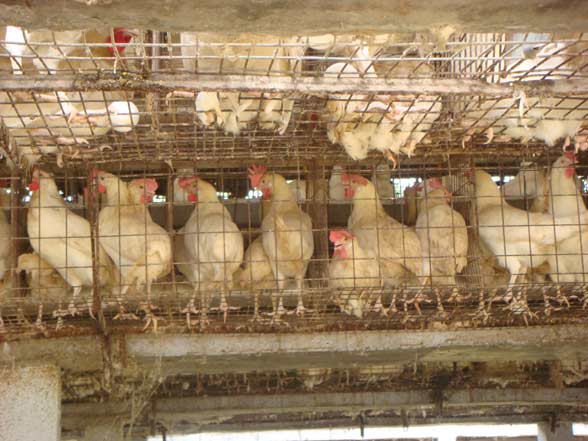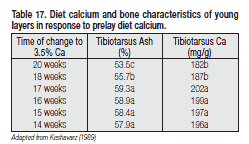Feeding Programs for Laying Hens: Cage Layer Fatigue
Cage Layer Fatigue
As its name implies, cage layer fatigue (CLF) is a syndrome most commonly associated with laying hens held in cages, and so its first description in the mid 1950’s coincides with commercial acceptance of this housing system. Apart from the cage environment, CLF also seems to need a high egg output to trigger the condition, and for this reason, it has traditionally been most obvious in White Leghorns. At around the time of peak egg output, birds become lame, and are reluctant to stand in the cage. Because of the competitive nature of the cage environment, affected birds usually move to the back area of the cage, and death can occur due to dehydration/starvation because of their reluctance to drink or eat. The condition is rarely seen in litter floor managed birds and this leads to the assumption that exercise may be a factor. In fact, removing CLF birds from the cage during the early stage of lameness and placing them on the floor, usually results in a complete recovery. However, this practice is usually not possible in large commercial operations. In the 1960-70’s up to 10% mortality was common, although now the incidence is considered problematic if 0.5% of the flock are affected. There is no good evidence to suggest an association of CLF to general bone breakage in layers, although the two conditions are often described as part of the same general syndrome.
If birds are identified early, they seem alert and are still producing eggs. The bones seem fragile, and there may be broken bones. Dead birds may be dehydrated or emaciated, simply due to the failure of these birds to eat or drink. The ribs may show some beading although the most obvious abnormality is a reduction in the density of the medullary bone trabeculae. Paralysis is often due to fractures of the fourth and fifth thoracic vertebrae causing compression and degeneration of the spinal cord. If birds are examined immediately after the paralysis is first observed, then there is invariably a partly shelled egg in the oviduct, and the ovary contains a rich hierarchy of yolks. If birds are examined some time after the onset of paralysis, then the ovary is often regressed, due to reduced nutrient intake.

CLF is obviously due to an inadequate supply of calcium available for shell calcification, and the bird’s plundering of unconventional areas of its skeleton for such calcium. Because calcium metabolism is affected by the availability of other nutrients, the status of phosphorus and vitamin D3 in the diet and their availability are also critical. Birds fed diets deficient in calcium, phosphorus, or vitamin D3 will show cage layer fatigue assuming there is a high egg output.
Calcium level in the pre-lay period is often considered critical in preventative measures for CLF. Feeding low calcium (1%) grower diets for too long a period, or even 2% calcium pre-lay diets up to 5% egg production often leads to greater incidence of abnormal bone development. It has been suggested that the reappearance of CLF in some commercial flocks may be a result of too early a sexual maturity due to the genetic selection for this trait coupled with early light stimulation. Feeding a layer diet containing 3.5% Ca vs a grower diet at 1% Ca, as early as 14 wk of age, has proven beneficial in terms of an increase in the ash and calcium content of the tibiotarsus (Table 17).

Feeding a high calcium diet far in advance of maturity seems unnecessary, and in fact, may be detrimental in terms of kidney urolithiasis. Changing from a low to a high calcium diet should coincide with the observation of secondary sexual characteristics, and especially comb development which usually precedes first oviposition by 14-16 days.
There have been surprisingly few reports on the effect of vitamin D3 on CLF in young birds. It is assumed that D3 deficiency will impair calcium utilization, although there are no reports of testing graded levels of this nutrient as a possible preventative treatment. The other major nutrient concerned with skeletal integrity is phosphorus, and as expected, phosphorus deficiency can accentuate effects of CLF. While phosphorus is not directly required for shell formation, it is essential for the replenishment of Ca, as CaPO4, in medullary bone during successive periods of active bone calcification. Without adequate phosphorus in the diet, there is a failure to replenish the medullary Ca reserves, and this situation can accelerate or precipitate the onset of CLF and other skeletal problems. Low phosphorus intake is sometimes caused by the trend towards lower levels of diet phosphorus coupled with very low feed intake of pullets through early egg production.
Bone Breakage
In Older Hens CLF may relate to bone breakage in older hens, although a definitive relationship has never been verified. It is suspected that like the situation of CLF with young birds, bone breakage in older birds results as a consequence of impaired calcification of the skeleton over time, again related to a high egg output coupled with the restricted activity within the cage environment. Few live birds have broken bones in the cage, the major problem occurring when these birds are removed from their cages and transported to processing units. Apart from the obvious welfare implications, broken bones prove problematic during the mechanical deboning of the muscles.
Adding more calcium to the diet of older layers does not seem to improve bone strength, and in certain situations can lead to excessive eggshell pimpling. Adding both calcium and phosphorus to the diet has given beneficial results in some instances, although results are quite variable. In young birds at least, adding 300 ppm flourine to the water has improved bone strength, although there are no reports of such treatment with end of lay birds. Moving birds from a cage to litter floor environment seems to be the only treatment that consistently improves bone strength. This factor indicates that exercise per se is an important factor in bone strength of caged birds, but does not really provide a practical solution to the problem at this time.
It is not currently known how to improve the bone integrity of older high producing hens, without adversely affecting other traits of economic significance. For example, it has been shown that bone breaking strength in older birds can be increased by feeding high levels of vitamin D3. Unfortunately, this treatment also results in an excessive pimpling of the eggshells (as occurs with extra calcium) and these extra calcium deposits on the shell surface readily break off causing a leakage of the egg contents. It may be possible to improve the skeletal integrity of older birds by causing cessation of ovulation for some time prior to slaughter. Presumably, the associated reduction in the drain of body calcium reserves would allow re-establishment of the integrity of the susceptible medullary bones. Currently, such a feeding strategy is uneconomical, although consideration for bird welfare may provide the impetus for research in this area.
This article hasn't been commented yet.


Write a comment
* = required field